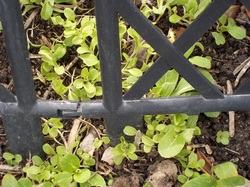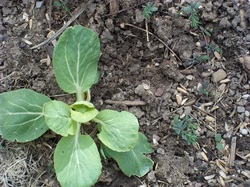
I'm really looking forward to eating them in a couple weeks!

Plants that are growing in my garden now are onion, peas, kohlrabi, cabbage, beets, leaf lettuce, carrots, Swiss chard, parsley, rhubarb, horseradish. There are lots more that will grow now; see Gardening 101 for more of them. My garden has been pretty neglected this spring so far; the only reason the items above are growing is that 1) I let them self-seed, or 2) they overwintered.
If you're new to gardening, start with 2-4 kinds of plants. A great resource for both new and veteran gardeners is the "In The Garden" series from the USU Extension Office. This series covers 55 different garden vegetables, herbs, and fruits: from Artichoke and Asparagus, to Wasabi, Watercress, and Watermelon. (You thought I'd say Zucchini last, didn't you! It's listed under "Summer and Winter Squash".) Each one has 1-2 pages of information on what type of soil the plant prefers, how much sun it needs, what nutrients it needs to thrive, and more.
If you wanted to start tomatoes or other plants indoors, you still can. Remember that some things can be planted directly in the garden as seeds now (see above). If you can avoid transplanting, it saves the plants some stress. One of my favorite garden helpers is called a Wall-O-Water. Frost-sensitive plants, like tomatoes, peppers, and watermelon, can go outside even now, if they're protected by them. Most garden centers sell them, three to a package, for around $10. Use them year after year, too.
If you're still looking for indoor seed-starting information, here's a quick summary:
Simple version of instructions for starting seeds indoors
Use any clean container with good drainage. You can use commercial planting trays or pots, or poke holes in the bottom of yogurt containers, paper cups, eggshell halves, or whatever you have. You can even use cardstock or a couple layers of newspaper to form little boxes or pots. Or cut 1 ½-2” lengths of toilet paper tubes to fill with dirt and plant in. Use a cookie sheet or plastic bin’s lid underneath your planting pots, to protect surfaces below. Plant the seeds in a lightweight mix, not garden soil. Keep moist and dark, and covered, until they sprout. Putting them on top of a freezer or furnace will warm the soil and help them germinate.
After sprouts appear, for best results, use a fluorescent shop light suspended 4-6” above the plants. 14-18 hours a day is ideal. Plants will be tall and scraggly when they don’t have enough light. They sometimes will fall over, damage the stem that way, and die. Water them only after the top of the soil has dried out. If you’re not sure how often to water, poke your finger down ½” below the soil’s surface. If it feels cool there, it is still moist. Overwatering leads to fungus and diseases. Use a little fertilizer in the water every day.
They can be transplanted after their second set of true leaves appear. They’ll only be a couple inches tall if they’ve had enough light. If the garden’s not ready for them, you can transplant them into larger pots so the roots can keep growing. You may use plastic containers (yogurt cups, cottage cheese containers) with holes punched in the bottom.
For more information, see:
Starting vegetable seed indoors: http://extension.usu.edu/saltlake/files/uploads/pdf/Starting%20Seed%20Indoors.pdf
http://extension.usu.edu/htm/news-multimedia/articleID=12035
Space requirements for vegetables:
http://extension.usu.edu/htm/publications/by=category/category=
__________________________________
Sweet Onion Poppyseed Dressing
1 Tbsp. poppyseed
1 Tbsp. prepared mustard
1 c. light olive oil (or other oil)
½ c. vinegar (I prefer apple cider vinegar here)
½ c. sugar*
1 tsp. salt
1 small onion, or a piece the size of a small egg
Mix everything in a blender until smooth.
*If you want to reduce the sugar, cook a whole medium or large onion in 1 Tbsp. of the oil until tender. Cover and cook on low another 10 minutes, until caramelized. This makes it sweeter. Mix the dressing as above. Add 1-2 teaspoons of sugar for best flavor. Use immediately or store in fridge.
This recipe came from a neighbor ten years ago; (it's been modified a bit by me) and was from her grandmother. The salad she poured it on was made with spinach, lettuce, sliced onion, crumbled bacon, sliced mushrooms, peas, Swiss cheese, and cashews. One of my favorite salads. Ever.
 RSS Feed
RSS Feed